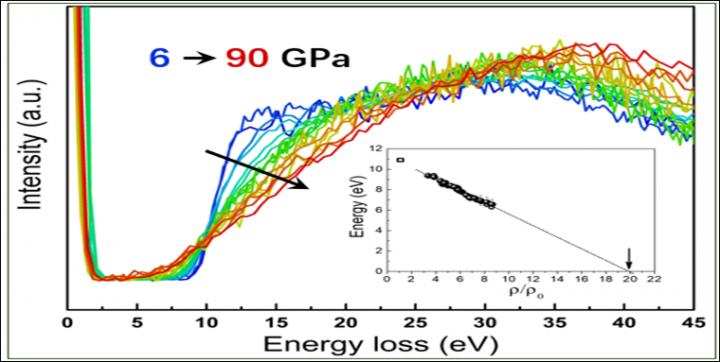
Credit: Bing Li
Utilizing a newly developed state-of-the-art synchrotron technique, a group of scientists led by Dr. Ho-kwang Mao, Director of HPSTAR, conducted the first-ever high-pressure study of the electronic band and gap information of solid hydrogen up to 90 GPa. Their innovative high pressure inelastic X-ray scattering result serves as a test for direct measurement of the process of hydrogen metallization and opens a possibility to resolve the electronic dispersions of dense hydrogen. This work is published in the recent issue of Physical Review Letters.
The pressure-induced evolution of hydrogen’s electronic band from a wide gap insulator to a closed gap metal, or metallic hydrogen, has been a longstanding problem in modern physics. However, hydrogen’s remarkably high energy has prevented the electronic band gap from being directly observed under pressure before. Existing probes, such as electrical conductivity, optical absorption, or reflection spectroscopy measurements, are limited and provide little information on a wide-gap insulator. “All previous studies of the band gap in insulating hydrogen under compression were based on an indirect scheme using optical measurements,” explains Dr. Mao.
The team used high-brilliance, high-energy synchrotron radiation to develop an inelastic x-ray (IXS) probe, yielding electronic band information of hydrogen in situ under high pressure in a diamond anvil cell (DAC). “The development of our DAC-IXS technique for this project took an international team of many experts in synchrotron inelastic X-ray spectroscopy, instrumentation, and ultra-high-pressure techniques over five years to complete,” said Dr. Bing Li, the first author.
“Actually, the real beginning of this project can be traced back more than 20 years, and these results are the culmination of all that preparation and experimentation. A true testament to the enormous efforts and talents of the team involved,” said Dr. Mao. The novel IXS probe technique enabled an inaccessible and extensive UV energy range of 45 eV to be measured, showing how dense hydrogen’s electronic joint density of states and band gap evolve with pressure. The electronic band gap decreased linearly from 10.9 eV to 6.57 eV, with an 8.6 times densification from zero pressure up to 90 GPa.
These developments in state-of-the-art synchrotron capabilities with submicron to nanometer-scaled X-ray probes will only extend future experimental possibilities. Advances of IXS to higher pressure could place the semiconducting region of phases II-V within reach and enable the study of hydrogen metallization through direct and quantitative electronic band gap measurements.
This work overcomes formidable technical challenges, achieving direct experimental measurements of hydrogen’s electronic band and its gap for the first time.
###
More information: Probing the Electronic Band Gap of Solid Hydrogen by Inelastic X-Ray Scattering up to 90 GPa, Li et al., Phys. Rev. Lett. 126, 036402.
Media Contact
Haini Dong
[email protected]
Related Journal Article
http://dx.




